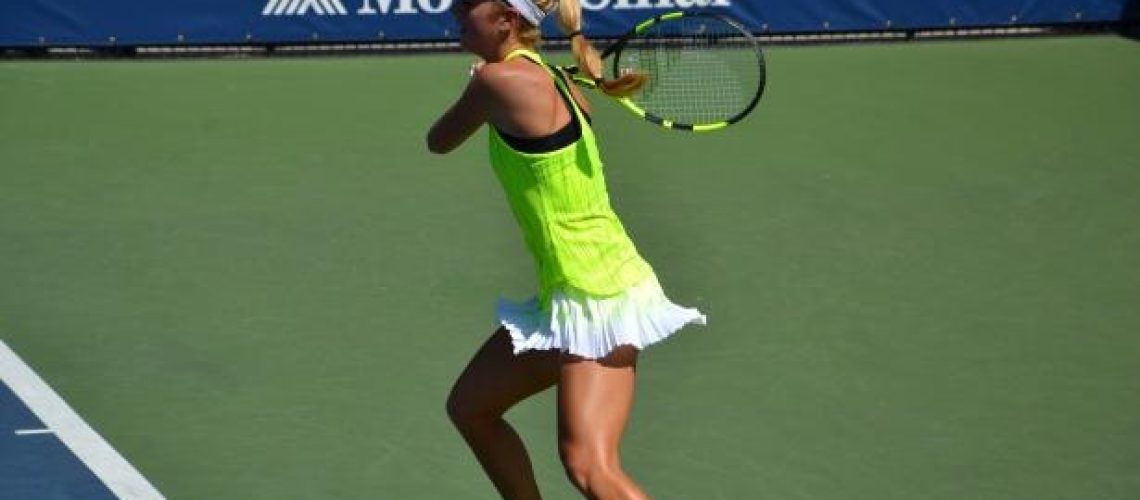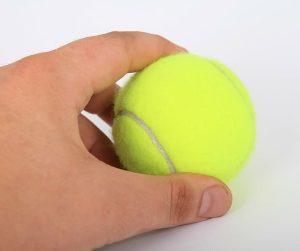We may earn money or products from the companies mentioned in this post.
Brief Overview of Spin in Tennis

Spin is a critical aspect of tennis that can make or break a player’s game It refers to the rotation imparted on the ball during a shot, which influences its trajectory and bounce upon landing The ability to generate and control spin is crucial for players of all skill levels, from beginners to professionals
Tennis spins can be broadly categorized into three types: topspin, backspin (also known as slice), and sidespin (also referred to as “swerve” or “curving” spin). Each type has its unique characteristics and applications on the court
1 Topsin
Topsin is one of the most commonly used spins in tennis When executing this technique, players brush the ball from low-to-high with an upward motion, causing it to rotate forward as it travels through the air This rotation creates a downward force upon landing, allowing the ball to clear the net easily while maintaining control and depth
2 Backspin (Slice)
Backspin, often called slice, involves hitting the lower part of the ball with an angled racket face, producing a backward rotation This spin causes the ball to dip quickly after crossing the net due to increased air resistance against its spin direction Backspin shots are ideal for defensive play, as they create low bouncing balls that are challenging for opponents to attack effectively
3 Sidespin
Sidespin occurs when players strike off-center on the ball’s horizontal axis, causing it to rotate sideways during flight This lateral rotation alters the trajectory of the shot unpredictably and poses difficulties for opponents in anticipating where it will land or how it will behave after bouncing Skilled players often employ sidespin shots strategically to create angles or exploit their opponent’s weaknesses
The Benefits of Mastering Spin Techniques

Mastering spin techniques in tennis can significantly elevate a player’s game and provide them with a competitive edge Here are some key benefits:
1 Increased Ball Control and Precision
By mastering different spins, players gain better control over the ball’s trajectory, speed, and bounce This enhanced control allows for more precise shot placement, making it easier to hit shots close to the lines or exploit gaps in the opponent’s defense The ability to manipulate spin also enables players to counter their opponent’s shots effectively, adding an extra layer of defensive prowess to their game
2 Enhanced Game Strategy and Competitiveness
The mastery of spin techniques opens up a whole new dimension of game strategy Players can use varied spins strategically to disrupt their opponents’ rhythm, force errors, or create opportunities for attacking shots Additionally, by introducing different spins into their shots, players can keep their opponents guessing and make it more challenging for them to anticipate the ball’s behavior after bouncing
The Art of Topsin: Mastering the Physics and Techniques

When it comes to tennis, there’s a technique that can give your shots an extra edge – topspin This powerful technique not only affects the trajectory and bounce of the ball but also leaves opponents scrambling to respond Understanding the physics behind topspin and mastering the step-by-step execution will elevate your game to new heights
The Physics Behind Topsin
1 Effects on Ball Trajectory and Bounce:
By applying topspin to your shots, you create forward rotation on the ball As a result, the ball travels in an arc-like trajectory, dipping over the net before descending towards your opponent’s side of the court with increased speed and control The combination of speed and angle makes it challenging for opponents to return effectively
2 Impact on Opponents’ Reactions:
Topsin can wreak havoc on your opponent’s ability to anticipate and react swiftly The downward force generated by topspin shortens their reaction time as they struggle to adjust their positioning for balls that seem to defy gravity by staying low while clearing the net
Step-by-Step Instructions for Executing a Topsin Shot
1 Proper Grip for Generating Topspin:
To generate optimal topspin, employ an Eastern or Semi-Western grip These grips allow you to naturally brush up against the back of the ball during contact, creating maximum spin
2 Correct Stance and Body Positioning:
A solid foundation is crucial for executing a successful topspin shot Ensure a balanced stance with feet shoulder-width apart, knees slightly bent, and weight evenly distributed between both feet
3 Timing the Swing for Optimal Contact:
a) Low-to-High Motion:
As you prepare to strike the ball, initiate a low-to-high motion with your racket This upward swing path allows you to create the necessary spin and lift on the ball
b) Brushing Up Against the Back of the Ball:
At the point of contact, focus on brushing up against the back of the ball with your racket strings This action generates topspin by imparting forward rotation onto the ball’s surface
4 Follow-Through Tips for Consistency and Accuracy:
To ensure consistency and accuracy in your topspin shots, pay attention to your follow-through Maintain a smooth and controlled motion as you complete your swing, allowing your racket to continue its upward trajectory towards your target A well-executed follow-through will enhance both power and control
With these insights into topspin technique, you’re now equipped to take your tennis game to new heights Mastering this powerful technique requires practice and patience, but once perfected, it can become a formidable weapon in your arsenal So grab your racket, hit the court, and start unleashing devastating topspin shots that will leave opponents in awe!
Backspin (Slice) Technique

Understanding how backspin affects ball movement
When it comes to mastering the art of tennis, understanding the impact of backspin on ball movement is crucial Backspin, also known as slice, refers to a technique where the player imparts underspin on the ball during their shot This underspin creates a unique effect on the trajectory and behavior of the ball
1 Explanation of underspin effect on shots:
Underspin causes the ball to rotate in a backward direction as it moves through the air, resulting in a downward force upon landing This phenomenon reduces bounce height and makes it challenging for opponents to anticipate and handle the shot effectively
2 Advantages in defensive play and shot variety:
The backspin technique offers players several advantages, particularly when it comes to defensive play and shot variety By incorporating backspin into their shots, players can generate low-bouncing balls that stay close to the ground, making them difficult for opponents to attack with power or precision Additionally, utilizing backspin allows players to create variations in speed and trajectory, adding an element of surprise to their gameplay
How to perform a slice shot with backspin
To execute a successful slice shot with backspin requires proper technique and attention to detail
1 Choosing an appropriate grip:
Selecting an appropriate grip is essential for executing a slice shot effectively The Continental or Eastern grips are commonly used for generating backspin since they allow greater control over racket head positioning during contact with the ball
2 Proper footwork for balance and stability:
Footwork plays a vital role in maintaining balance and stability while performing a slice shot with backspin Ensuring proper positioning and weight transfer between the feet enables players to generate power and control during their shot
3 Swing mechanics to generate backspin:
To create backspin, players must employ specific swing mechanics:
a) High-to-low motion:
Initiate your shot with a high-to-low motion, allowing the racket face to move from above the ball towards a downward position at impact This motion helps create the necessary contact angle for generating backspin effectively
b) Slicing beneath the ball:
As you make contact with the ball, aim to slice beneath it, brushing the racket strings against its lower half This action imparts underspin on the ball, resulting in a desirable slicing effect
4 Finishing touches for optimal results:
To optimize your slice shot with backspin, focus on follow-through and body positioning Maintain a smooth follow-through after striking the ball and ensure that your body remains balanced and aligned throughout the entire stroke
By following these guidelines and practicing regularly, you can master the art of executing a slice shot with backspin, adding depth and versatility to your tennis repertoire
Sidespin Technique: Mastering the Art of Spin Shots

When it comes to adding finesse and unpredictability to your shots in sports like tennis or table tennis, mastering the sidespin technique can give you a significant advantage This technique involves imparting spin on the ball, causing it to curve or change direction mid-flight Let’s dive into the mechanics behind sidespin shots and how you can generate effective sidespin in your game
Mechanics behind Sidespin Shots
1 Types of Sidespins: Inside-Out and Curving Balls
Sidespin shots come in two variations: inside-out (side-spin) and curving balls The inside-out sidespin is when the ball curves away from you, while curving balls have a lateral movement towards either side Understanding these types of spins will help you determine the right approach for each shot
2 Changing Direction Mid-Flight
One of the fascinating aspects of sidespin shots is their ability to change direction unexpectedly during flight By skillfully manipulating the spin on the ball, you can deceive your opponent and create opportunities for winning points
Generating Sidespin in Your Game
To become proficient at executing sidespin shots, you need to master several key elements:
-
Choosing the Right Grip:
Opt for a grip that allows you to maneuver your racket with ease and precision, such as the Continental grip commonly used by professional players -
Footwork and Body Positioning:
Proper footwork and positioning are crucial for generating power and control in your shots Position yourself correctly relative to the ball’s trajectory to maximize your chances of executing an effective sidespin shot -
Swing Technique:
The key to imparting sidespin on the ball lies in your swing technique Brushing across the back of the ball with your racket strings is a common method used to create spin Adjustments should be made depending on whether you want to execute an inside-out or curving shot -
Brushing Across the Back of the Ball:
For standard sidespin shots, brushing across the back of the ball at an angle will produce the desired spin and movement -
Adjustments for Inside-Out or Curving Balls:
To execute an inside-out shot, apply more force and brush across the back of the ball from right to left (for a right-handed player). Curving balls require a slightly different technique, where you brush across with a slight upward motion to create lateral movement -
Follow-Through and Recovery Steps:
After striking the ball, ensure you have a smooth follow-through and quickly recover your position on the court This will set you up for your next shot while maintaining balance and control
By incorporating these techniques into your game, you’ll be able to add depth and variety to your shots with sidespin Practice diligently, experiment with different spins, and observe how they affect your opponents’ reactions Soon enough, you’ll become a master of spin shots that keep your opponents guessing
In conclusion,
Conclusion

Throughout this article, we’ve delved into the world of spin techniques in tennis and explored their importance in gameplay Let’s take a moment to recap the key points we’ve covered:
Recap of Key Points about Spin Techniques in Tennis
1 Spin is a vital aspect of tennis that can significantly impact your shots and overall game strategy
2 Topspin allows you to generate more power, control the trajectory of the ball, and make it bounce higher upon landing
3 Backspin, also known as slice, creates a lower bounce and can be used for defensive shots or to surprise your opponent
4 Sidespin, or the ability to impart sidespin on the ball, adds an element of unpredictability to your shots and can help you manipulate angles on the court
Encouragement to Practice and Incorporate Spins into Gameplay
Now that you understand the importance of spin techniques in tennis, it’s time to put them into practice! Don’t be afraid to experiment with different spins during your training sessions and matches
Incorporating spins into your gameplay will not only make it more exciting but also give you a competitive edge over your opponents Take inspiration from professional players who masterfully utilize spins in their strategies
Remember, learning any new skill takes time and effort Be patient with yourself as you work on perfecting your spin techniques – it will pay off in the long run!
Tips for Continued Improvement and Development
-
Dedicate specific practice sessions:
Set aside focused practice sessions solely dedicated to improving your spin techniques This will allow you to concentrate on the specific aspects you need to work on -
Seek guidance:
Consider taking lessons from a qualified tennis coach who can provide valuable insights and correct any technical errors in your spin technique -
Analyze professional players:
Watch matches of professional tennis players known for their exceptional spins Observe their footwork, racquet preparation, and timing to gain insights into how they execute their shots -
Experiment with different spins:
Don’t limit yourself to just one type of spin Explore different varieties of topspin, backspin, and sidespin to expand your repertoire and keep your opponents guessing -
Mental preparation:
Develop mental resilience and focus during matches by visualizing successful execution of spin shots Confidence plays a crucial role in implementing spins effectively under pressure
Incorporating spins into your tennis game will not only enhance your overall skill set but also add excitement and versatility to your gameplay So embrace these techniques, practice diligently, and watch as your performance on the court reaches new heights!
Useful Links

Spindirection
4 Types of Ball Spin Pro Tennis Players Use
Ball Control – Win with Spin
Topspin – Wikipedia
The Mind-Bending Physics of a Tennis Ball’s Spin
How to hit a tennis ball with spin | Smart Tips
how to put spin on tennis ball
How Important Is Spin In Tennis? – The Racket Life
How to Spin the Ball in Wii Tennis
How to Spin a Ping Pong Ball: 6 Techniques Explained
Why You Need Topspin In Tennis
Topspin Tennis – Is More Better
Video Games: Wii Sports Tennis – Tips and hints
Spin in Table Tennis – How Does it Work and How Do You …
Understanding Ball and Spin
Learning Spin Consistency in Tennis
Ways to Spin the Ball






